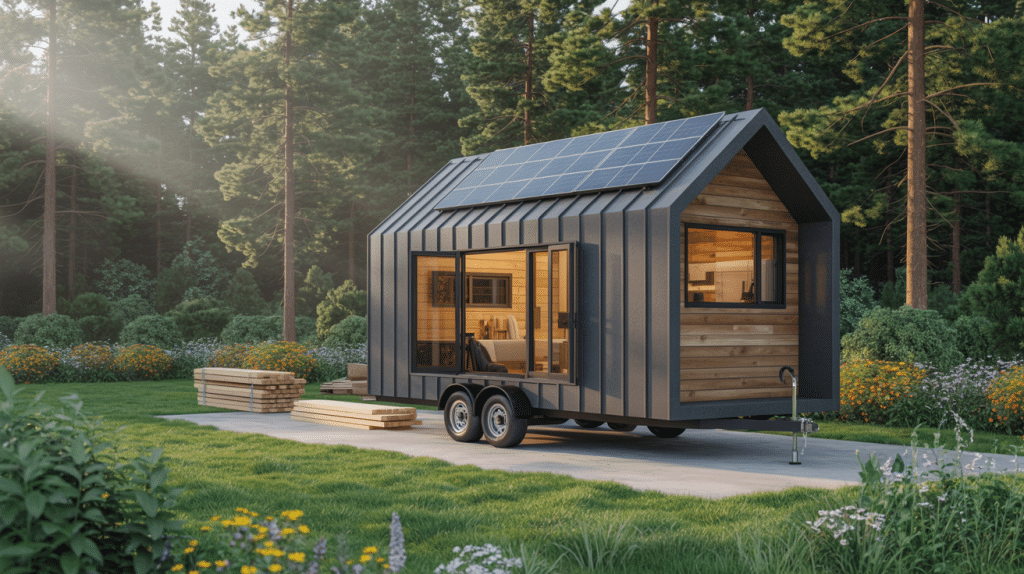Building your own tiny house can feel exciting. You get to design a space that fits your life and budget.
Building mine was one of the most exciting projects I’ve ever taken on. I loved the idea of creating a space that truly fit my life.
But before I even started, I needed to answer one big question: how much does it cost to build a tiny house? The truth is, there’s no one-size-fits-all number. Your costs will depend on your building method, materials and location.
I’ve seen people make it happen for around $15,000, while others have spent well over $150,000. In this post, I’ll break down each major cost factor so you can plan with confidence and avoid expensive surprises.
How Much Does It Cost to Build a Tiny House
So, how much does a tiny house cost? Most tiny houses cost between $30,000 and $150,000 to build. The national average sits around $65,000 for a complete build.
Tiny houses typically cost $150 to $400 per square foot. Traditional homes cost about $100 to $200 per square foot. This means tiny houses cost more per square foot, but your total cost stays much lower.
Here’s a quick breakdown by budget level:
Budget Builds: $15,000 – $30,000
- Basic materials and DIY labor
- Simple layouts with minimal features
- Often built on trailers
Mid-Range Builds: $30,000 – $80,000
- Quality materials with some professional help
- Standard appliances and fixtures
- Good insulation and electrical work
High-End Builds: $80,000 – $150,000+
- Premium materials and professional construction
- Custom cabinetry and high-end appliances
- Advanced systems like solar panels
Your final cost comes down to the choices you make for design, finishes, and construction method.
Factors That Affect the Cost of Building a Tiny House

Before you set a budget for your tiny house, it’s important to understand the factors that can raise or lower the total cost. Here are the main things to consider:
1. Size of the Home
Size directly impacts your total cost. Most tiny houses range from 100 to 400 square feet.
A 200 square foot home will cost roughly twice as much as a 100 square foot space. The difference comes from materials, labor time, and complexity.
Smaller homes under 200 square feet keep costs low. Larger homes over 300 square feet approach traditional construction costs.
2. Materials
Your material choices make a huge difference in final costs.
Basic materials like pine lumber, vinyl flooring, and standard fixtures keep budgets tight. Premium materials like hardwood, stone counters, and designer fixtures can double your costs.
Reclaimed materials offer a middle ground. You save money while getting a unique character. Old barn wood, salvaged windows, and used appliances cut costs significantly.
3. Foundation Type
You have two main foundation options: wheels or permanent.
Trailer foundations cost $3,000 to $7,000. This includes the trailer, tie-downs, and basic setup. Mobile tiny houses offer flexibility but face more legal restrictions.
Permanent foundations cost $5,000 to $15,000. This covers concrete pours, utility connections, and site prep. Permanent homes qualify as traditional housing in most areas.
4. Labor
Labor represents your biggest potential savings or expense.
DIY builds can save you $20,000 to $50,000 in labor costs. You’ll need basic construction skills, tools, and plenty of time. Most DIY builds take 6 months to 2 years to complete.
Professional builds cost $50 to $120 per square foot for labor. Contractors handle permits, inspections, and warranty work. Professional builds finish in 2 to 6 months.
5. Location
Regional costs vary significantly across the country.
Rural areas typically cost 20-30% less than urban markets. Material delivery costs more, but labor and permits cost less.
High-cost areas like California or New York add 40-60% to total costs. Low-cost areas like the Midwest or the South offer the best value.
6. Features & Finishes
Special features and upgrades add costs quickly.
Off-grid systems cost $10,000 to $30,000 extra. This includes solar panels, batteries, water tanks, and waste systems.
Custom-built-ins like Murphy beds, fold-out desks, and hidden storage add $2,000 to $8,000. High-end appliances and fixtures can add another $5,000 to $15,000.
Tiny House Cost Comparison
Looking at real-world examples can give you a clearer idea of what building a tiny house might cost. Here’s a comparison to help you see the range:
| Category | Cost Components | Estimated Cost Range | Pros | Cons |
|---|---|---|---|---|
| DIY Build | Materials: $15k–$50kTools: $2k–$5kPermits: $500–$2k | $17,500–$57,000 | Low cost, full control, skill building | Time-intensive, skills required, risk of mistakes |
| Professional Build | Materials & Labor: $40k–$120kPermits: $1k–$3k | $41,000–$123,000 | Fast, warranties, no learning curve | Higher cost, less flexibility |
| Pre-Built (Shell Kit) | Kit: $15k–$40kDelivery: $2k–$8k | $17,000–$48,000 | Structure done, interior flexible | Finish the work required |
| Pre-Built (Turn-Key) | Home: $50k–$120kDelivery: $2k–$8k | $52,000–$128,000 | Move-in ready | Premium price, limited changes |
| Custom-Built | Varies by design & finishes | Varies widely | Tailored layout, material choice | Longer build time, budget creep |
Cheaper options require more work, while pricier builds offer speed and convenience. Choose based on your skills, budget, and timeline.
Hidden and Ongoing Costs to Consider While Building a Tiny House
The upfront build isn’t the only expense when it comes to a tiny house. There are hidden and ongoing costs that can add up over time. Here’s what to keep in mind:
Permits and Legal Costs
Building permits cost $500 to $3,000, depending on location. Some areas require architectural plans, adding another $1,000 to $5,000.
Zoning compliance can be tricky. Many areas don’t allow tiny houses as primary residences. Legal consultation costs $150 to $300 per hour.
Land Costs
You need somewhere to put your tiny house. Land purchase costs vary wildly by location. Rural lots start around $10,000 while urban lots can cost $50,000 or more.
RV parks and tiny house communities charge $200 to $1,000 per month. Some include utilities while others charge separately.
Utilities and Systems
Connecting to city utilities costs $2,000 to $8,000 for water, sewer, and electrical hookups.
Off-grid systems cost more upfront but eliminate monthly utility bills. Expect $15,000 to $35,000 for complete solar, water, and waste systems.
Insurance and Maintenance
Tiny house insurance costs $300 to $1,000 per year. Coverage depends on whether your home is mobile or permanent.
Annual maintenance costs about 1-2% of home value. This covers roof repairs, system maintenance, and regular upkeep.
Regional and Legal Considerations
Where you build your tiny house and the local laws you follow can have a big impact on your plans and budget. Here are some key factors to consider:
Cost Variations by Region
Southern states offer the lowest construction costs. Texas, Alabama, and Mississippi provide cheap materials and labor.
Western states cost the most due to higher wages and material costs. California, Washington, and Colorado add 40-60% to typical budgets.
Northeastern states fall in the middle range. New England offers good contractors but higher material costs.
Legal Requirements
Building codes vary significantly between states and municipalities. Some areas treat tiny houses like RVs. Others require full residential building codes. A few states have created special tiny house regulations.
Massachusetts, for example, allows tiny houses as ADUs (accessory dwelling units) in many towns. They must meet residential building codes and connect to utilities.
Research your local laws before starting construction. Code violations can be expensive to fix later.
Cost-Saving Tips for Building a Tiny House
Building a tiny house on a budget is possible if you plan carefully and make smart choices along the way. Here are some tips to help you save money without cutting quality:
- Use reclaimed materials: Save 30–50% by sourcing lumber and supplies from construction sites, old barns, or demolition projects.
- Shop discount outlets: Visit Habitat for Humanity ReStores for low-cost windows, doors, and appliances.
- Check online marketplaces: Monitor Craigslist and Facebook Marketplace for lightly used building materials.
- DIY selective projects: Take on painting, flooring, and basic electrical; hire pros for plumbing, structural, and HVAC work.
- Build in phases: Start with a shell and essentials, then add features as budget allows.
With the right strategies, you can keep costs down and still create a tiny house that’s comfortable, functional, and built to last.
Summing Up
While doing my own build, I quickly realized that every choice shaped the whole project. Size, materials, labor, and location all played a huge role in how much it cost and how much effort it took.
Doing the work myself gave me more control, but also meant taking on a lot more responsibility. On the other hand, hiring professionals made things run more smoothly and quickly, though I had to step back from some decisions.
I also learned to think beyond just construction; planning ahead for permits, land, and utilities saved me from big headaches later.
If this gave you a clearer picture of the process, take a look at other blogs for tips, practical advice, and real examples you can use!





